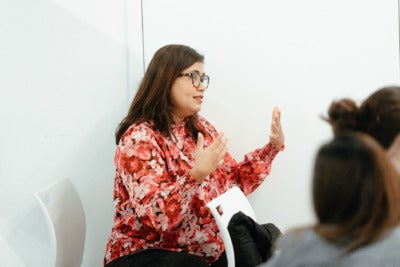New York is abuzz with the 78th UN General Assembly (UNGA) fever. Most world leaders came to UNGA78 to reaffirm their commitment to the achievement of the Sustainable Development Goals (SDGs) by 2030. However, the midway review this year showed that we are definitely not on track to achieve the SDGs unless we make drastic changes and think outside of the box.
In his opening remarks, UN Secretary General Antonio Guterres spoke candidly that the United Nations was not just for world leaders but also for women, children, and everyday citizens. He pointed out that women are being left out of important discussions and that the UN looked much the same as it did when it started 78 years ago – and that without women’s active involvement, the achievement of the SDGs will not be possible. Further, he called violence against women and girls an age-old scourge which needs to end and appealed for additional and more investment to tackle it – a sentiment echoed by political and development sector leaders.
On December 10 this year, we will celebrate the 75th anniversary of the Universal Declaration of Human Rights. I am reminded of this quote by one of the main architects of this declaration, American First Lady Eleanor Roosevelt:
“Where, after all, do universal human rights begin? In small places, close to home – so close and so small that they cannot be seen on any maps of the world. Yet they are the world of the individual person; the neighborhood he lives in; the school or college he attends; the factory, farm or office where he works. Such are the places where every man, woman and child seek equal justice, equal opportunity, equal dignity without discrimination. Unless these rights have meaning there, they have little meaning anywhere. Without concerned citizen action to uphold them close to home, we shall look in vain for progress in the larger world.”
I do believe that human rights and the SDGs go hand in hand and one cannot be achieved without the other. Several discussions and events had “localisation of development” as a theme – meeting people where they are and responding to their needs. It cannot be generalised. It means empowering them in their specific contexts and it is providing them with all kinds of resources to advance in the expression of their human rights. It also means being brave as a funder to trust the people on the ground to do the right thing and use their money in a way that serves their community in the best way possible.

New Voices Fellow ElsaMarie D’Silva speaks at the UN General Assembly
I had an opportunity to share my thoughts during the NGO Major Groups and other stakeholders’ session, “Breaking Down the Barriers to Leave No One Behind.”
In my panel, I shared about my work using Safecity, a crowd map for anonymous reporting of sexual and gender-based violence. Crowdsourced data has provided agency to individuals and communities to advocate for safer cities and demand more accountability, counter harmful gender stereotypes and norms and push for greater freedoms where women and girls could avail of their human rights. Given that we live in a world where technology is ubiquitous, it is important to bridge the digital divide and investment is needed to provide digital access and literacy. And because all these problems are too big for any of us to solve individually, coalitions and partnerships are key.
At the Aspen Institute’s Global Innovators Group event, we spoke about localisation and the need to invest in grassroots. Authentic partnerships truly invest in the success of not just the project, but also the leaders of the organizations guiding the efforts, including capacity building to help them think about their theory of change in an easy manner, providing flexible funding to meet the needs of the community, and long-term grants so that you could invest in solutions. For example, our Safecity partners around the world received advocacy grants to design, develop and implement campaigns that they felt were most relevant in their own communities for safer cities. Some of them went top down, engaging with mayors and city officials whilst others went bottom up, engaging local citizens. The loose structure of the partnership helped them be innovative and creative and did not put them under stress to replicate similar campaigns with little or no impact.
After 10 days of meetings at UNGA, I felt overwhelmed but also hopeful that leaders of government and donor agencies are realizing the importance of local interventions and especially – the contribution of women and girls. Now I hope they will fund and invest in these programs so that we can get on track to achieve the SDGs and all live happy lives.

